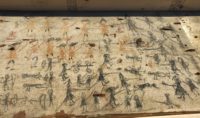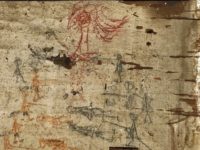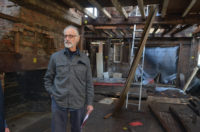 Restorers have discovered a battle scene believed to be from the French and Indian War drawn on the wall of a 17th-century home in East Hartford, Connecticut. A crew from the Glastonbury Restoration Company, a firm that specializes in restoring historic structures, was removing old plaster to reach the original wooden frame of the house when he uncovered a much older plaster wall covered with a mural five feet wide drawn in primitive style.
Restorers have discovered a battle scene believed to be from the French and Indian War drawn on the wall of a 17th-century home in East Hartford, Connecticut. A crew from the Glastonbury Restoration Company, a firm that specializes in restoring historic structures, was removing old plaster to reach the original wooden frame of the house when he uncovered a much older plaster wall covered with a mural five feet wide drawn in primitive style.
It’s a rudimentary drawing that is nonetheless incredibly active and detailed. In different colors of charcoal and chalk, it depicts a complex battle scene with soldiers in different colored uniforms, complete with winter coats and hats, cannon being moved on carts, Native Americans wielding bows and arrows and dead bodies with arrows protruding from them.  There’s even a mysterious red tree-like creature in the middle of the scene who appears to have some human facial features and is waving his thick branchy “hair” in the wind. Where was the Whomping Willow in the 1700s? (I demand a cut of any prequel JK Rowling writes based on this idea.)
There’s even a mysterious red tree-like creature in the middle of the scene who appears to have some human facial features and is waving his thick branchy “hair” in the wind. Where was the Whomping Willow in the 1700s? (I demand a cut of any prequel JK Rowling writes based on this idea.)
Glastonbury Restoration Company owner Steve Bielitz has found plenty of graffiti in the many houses he’s worked on over the years, but nothing even remotely like this. He showed the work to art experts in Connecticut and other states, among them University of Delaware architectural historian Michael Emmons Jr. who described it as an extremely rare 18th century “architectural sketch”
Emmons said he has documented thousands of graffiti and wall markings across the country. He said a vast majority were created by young males — ages 10 to 30 — but mostly by teenagers. He said although the drawing looks like it may have been created by a child, that’s not the case.
“Rudimentary drawings and less literate writings often reveal younger people’s handiwork, but admittedly, these things can also be misinterpreted because it “looks” like it’s done by a young person, when in reality it was done by someone who just couldn’t write or draw well,” he said.
Emmons said he believes the drawing could have been made by a family member after being told the story of the battle. […]
“My gut sense here is that these images were created by a younger person, rather than even a young soldier who has fought in a war. This does not preclude the possibility of these images being drawn by someone who actually participated in a war, which is definitely possible, but my instinct is that this is a younger person drawing a scene they’ve read about or heard about, or maybe even recreating an event that a family member experienced,” he said.
There certainly would have been a myriad opportunities for that kind of transmission. The home is the oldest surviving house in East Hartford, dating to the Colonial era around 1693. Its first owner was Jonathan Hills, the youngest son of William Hills who was one of the founders of Hartford. William Hills had emigrated to what was then the Massachusetts Bay Colony in 1632, and moved to Hartford four years later. He accrued significant property in a very short time, including more than 500 acres in land in an area of Hartford called Hockanum on the east bank of the Connecticut River. Hockanum would become East Hartford in 1783.
William Hills was a captain in the Hartford militia. His son William, Jr., died in King Philip’s war in 1675, shot by an Indian arrow. The family’s military tradition continued for generations. Jonathan was a lieutenant in the colonial regiments, as was his son David Ensign Hills and his son David. The latter is known to have to fought in the French and Indian War (1754–1763).
The artwork was made on the wall in situ, perhaps by a family member to entertain and educate the children. We know a renovation after 1850 covered the wall with another plaster wall because some of the figures in the mural were found behind a stud. The date hasn’t been able to be narrowed down any further than that yet. The drawing will be studied further by Michael Emmons at the University of Delaware. It will be analyzed with infrared photography and reflectance transformation imaging which may reveal details invisible the naked eye.
 As for its final disposition, that is up in the air at the moment. The house is still owned by descendants of the Hills family. They are having it dismantled piece by piece and moved to South Carolina. They own the mural, of course, as it is literally a piece of their house. They might put it back on the wall where it was discovered.
As for its final disposition, that is up in the air at the moment. The house is still owned by descendants of the Hills family. They are having it dismantled piece by piece and moved to South Carolina. They own the mural, of course, as it is literally a piece of their house. They might put it back on the wall where it was discovered.
The oldest surviving house in East Hartford is being dismantled and moved to South Carolina? So much for historic preservation.
This is not technically a “plaster wall”. The substrate appears to be white pine, with several coats of white-wash. It is most-probably a single, wide board, which will make moving it a breeze, though the surface is pretty delicate. The weird spalls in it are the results of square nails having been driven through- or almost-through- from the other side.
Personally, I suspect a ‘Tomahawk’ incapacitating an IT admin, or maybe a ‘hidden battle drawing’ being involved.
After 300 years, unfortunately, the ‘The Hartford Courant’ still seems ‘committedly‘ to be engaged on some rather obscure “…issues“:
—————
😮 :ohnoes: :no:
“Unfortunately, our website is currently unavailable in most European countries. We are engaged on the issue and committed to looking at options that support our full range of digital offerings to the EU market. We continue to identify technical compliance solutions that will provide all readers with our award-winning journalism.”
Where is the in situ photo?
Good and detailed blog.
When they say the oldest house in Hartford, I assume that they mean the part you can see in the background, which looks like a former exterior wall built in a relatively crude ‘cottage’ style.
While as a South Carolinian I love the thought of historic homes in our state, I can not believe that that home is allowed to be moved to my state. While it is technically their property, you would think it would be protected by local historic preservation laws. What a great loss for CT. I guess not only people are moving south to the Carolinas from up north. I hope they donate it to the local museum before they move- but I bet they keep it.
We attempted to restore this house as a museum and approached numerous organizations throughout the state of Connecticut but no one would step up to the plate . We advertised this with every significant marketing venue in the state of Connecticut for four years with no folks in CT coming forward. There should be more historical covenants in place but this location was not protected. This is an uphill battle. If one had been in our shoes, one might understand, why, ultimately, it was better to save the house and restore somewhere rather than see it “ fall to the wrecking ball.” I have much more to say, but I was also disappointed that we could not keep the house in the Hartford area.
Sincerely,
Steve Bielitz
That is not the case. I should probably post some photos of the interior of the house here, so that people can see the beautiful paneled walls and chamfered summer beams from the 1692 and 1742 period. This was found in a secondary area on floor two of the 1742 section of the house. This had been covered by later plaster circa 1860.
That is not the case. I should probably post some photos of the interior of the house here, so that people can see the beautiful paneled walls and chamfered summer beams from the 1692 and 1742 pperiod. This was found in a secondary area on floor two of the 1742 section of the house. This had been covered by later plaster circa 1860.